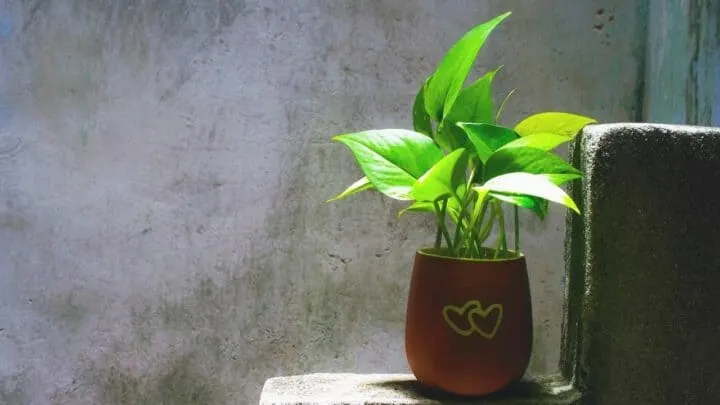12 Pothos Varieties, you must know. Pothos belongs to the aroid family Araceae, and its various varieties are widely available for plant-loving people.
Some of them are variegated, while others have solid leaves, so you have many options.
One thing worth mentioning about Pothos varieties is that all of them are toxic as they contain calcium oxalate crystals; therefore, grow them away from the reach of kids and pets.
Table of Contents
12 Pothos Varieties
- Golden Pothos
- Manjula Pothos
- Cebu Blue Pothos
- Pearl and Jade Pothos
- Silver Pothos
- Neon Pothos
- Marble Queen Pothos
- Snow Queen Pothos
- N Joy Pothos
- Jessenia Pothos
- Jade Pothos
- Glacier Pothos
12 Popular Pothos Varieties
Golden Pothos
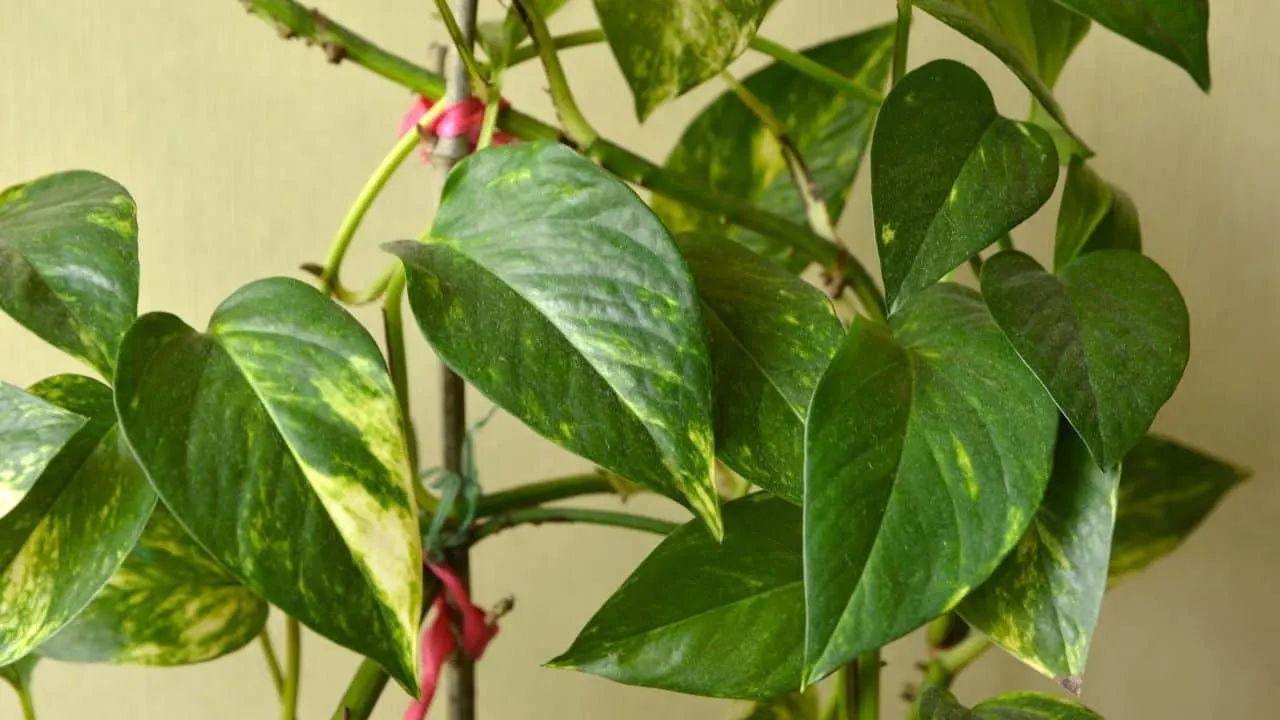
The variegated yellow leaves of the Golden Pothos variety add color to your indoor setting. Hang this plant in your bedroom or any dim house to let the leaves trail downwards.
This bright houseplant can also be trained to climb support or wall.
This variety is best suited for home growers with limited sunlight as it can grow in dim or dark areas. This plant is native to islands in South Pacific, and it grows 60 ft (18 m) in height.
Indoors also reach an average size of 5-12 ft (1.5-3.6m).
- Light: Moderate or low indirect sunlight
- Temperature: 60 to 85 degrees Fahrenheit (15.5 to 29 degrees Celsius)
- Humidity: 50 to 70%
- Water: Regular watering to keep the soil moist whenever the top 2 inches are dry
- Soil: Well-draining, neutral or acidic
- Common Issues: Mealybugs
- Scientific Name: Epipremnum Aureum
Read the full Golden Pothos Care article here.
Manjula Pothos
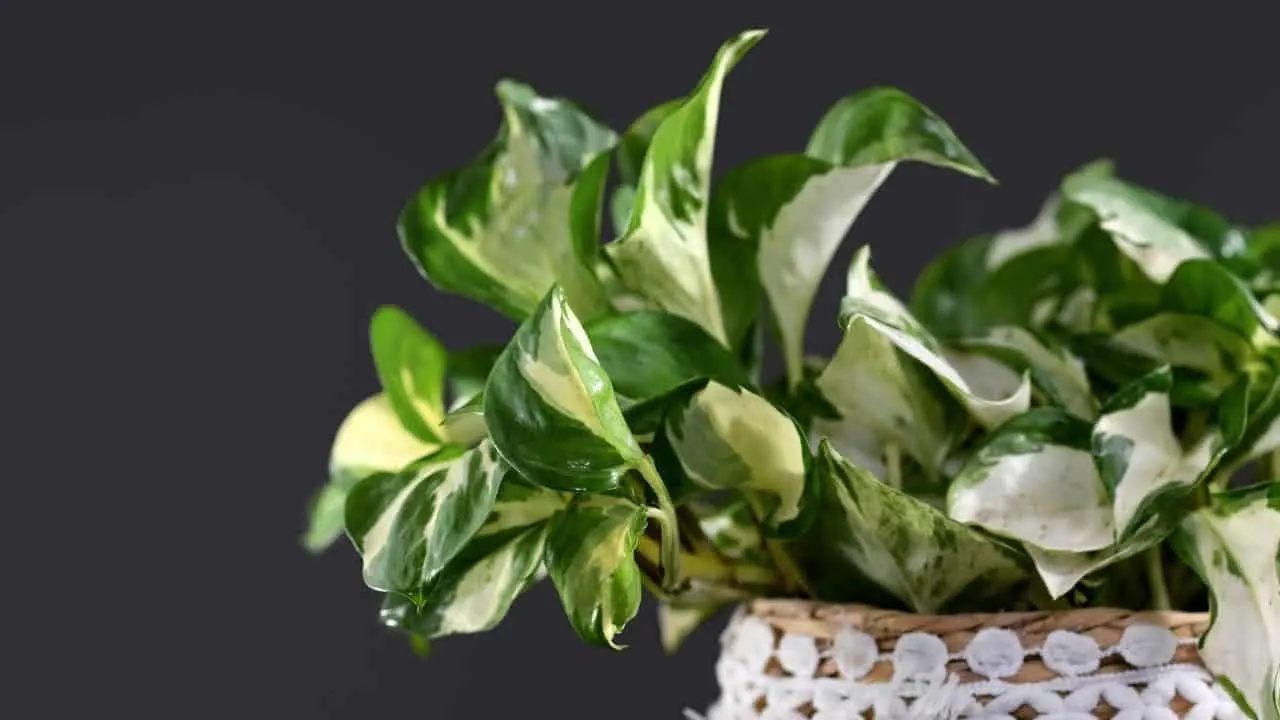
This Happy Leaf Pothos has eye-catching leaves in shades of cream and green. The marble-patterned heavy variegation on this plant makes it unique from others.
No two leaves on this plant are similar. This patented Pothos originated in India and was first introduced in 2010.
Most Pothos can survive in low light, but Manjula Pothos needs bright light for photosynthesis on the white leaves.
If the variegation starts disappearing, move your plant to a spot with more light.
This is a vining plant; if you maintain consistently high humidity, it will develop aerial roots for further plant growth.
The Manjula plant has a bushy growth pattern expanding both upwards and sideways. The leaves have slightly wavy edges, with less space between individual leaves.
This versatile plant can be grown indoors or outdoors, even inside a terrarium. Growing it in an open area means vines climbing up to 20 ft (6 m).
- Light: Bright, filtered sunlight
- Temperature: 50 to 95 degrees Fahrenheit (10 to 35 degrees Celsius)
- Humidity: 60 to 90%
- Water: Not drought tolerant, so needs water regularly
- Soil: Mixture with perlite, coco coir, and orchid bark
- Common Issues: Botrytis, bacterial leaf spot, and bugs, including spider mites, mealybugs, and scale insects.
- Scientific Name: Epipremnum Aureum ‘Manjula’
Cebu Blue Pothos
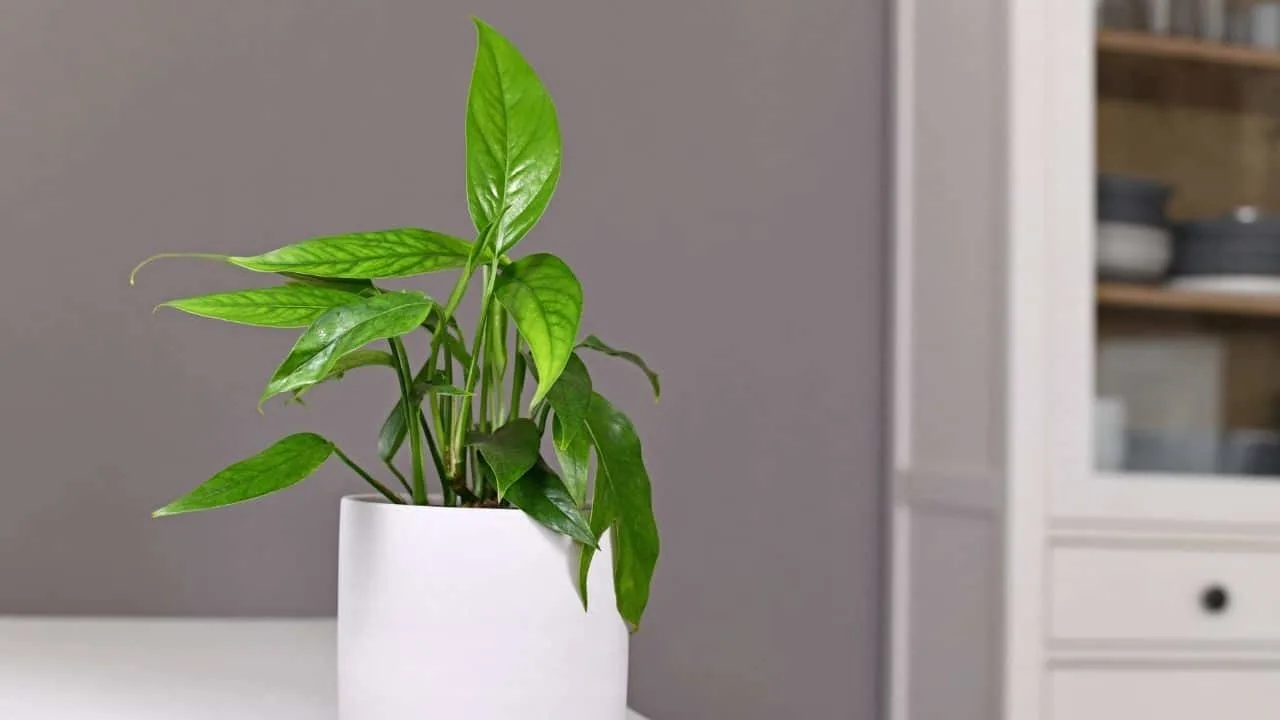
Cebu Blue Pothos differs from other Pothos varieties with its elongated pointy leaves. The silver and blue hues on the leaves make them shine under light.
Let it trail from a hanging basket or train it to climb on a moss pole. You can take care of this easily in both cases. Outdoors you can plant it under tall plants or trees.
Other nicknames for his plant include Blue Pothos, Centipede Tongavine, Schindapsus Aureum, and Dragon-tail plant. The color of the leaves depends on the growing stage; young leaves are bluish than mature ones.
The maximum length of the leaves is between 2 to 4 inches (5 to 10 cm). If you want to help your plant develop lush foliage, add a slow-release fertilizer.
The mature version of this plant has another surprise, the fenestration! As this plant matures, it develops zigzag patterns, but this slow grower takes time (lots of years) to reach maturity.
It’s named Cebu after Cebu Island in the Philippines, and the blue represents the coloration on the shiny leaves.
As an indoor plant, this variety reaches a maximum height of 4 to 10 ft (1.2 to 3 m), but outdoors it grows wild and reaches up to 40 ft (12 m).
You can propagate the Cebu Blue Pothos with a single leaf or a stem cutting from the mother plant.
- Light: Medium-light or bright indirect sunlight
- Temperature: 60 to 80 degrees Fahrenheit (15 to 26 degrees Celsius)
- Humidity: Average or high humidity between 60 and 90%
- Water: Does not require heavy watering; water when the top 1 inch is dry
- Soil: A chunky soil mix created using perlite, vermiculite, and orchid bark
- Common Issues: Leaf yellowing, browning, spider mites, mealybugs
- Scientific Name: Epipremnum Pinnatum
Pearl and Jade Pothos
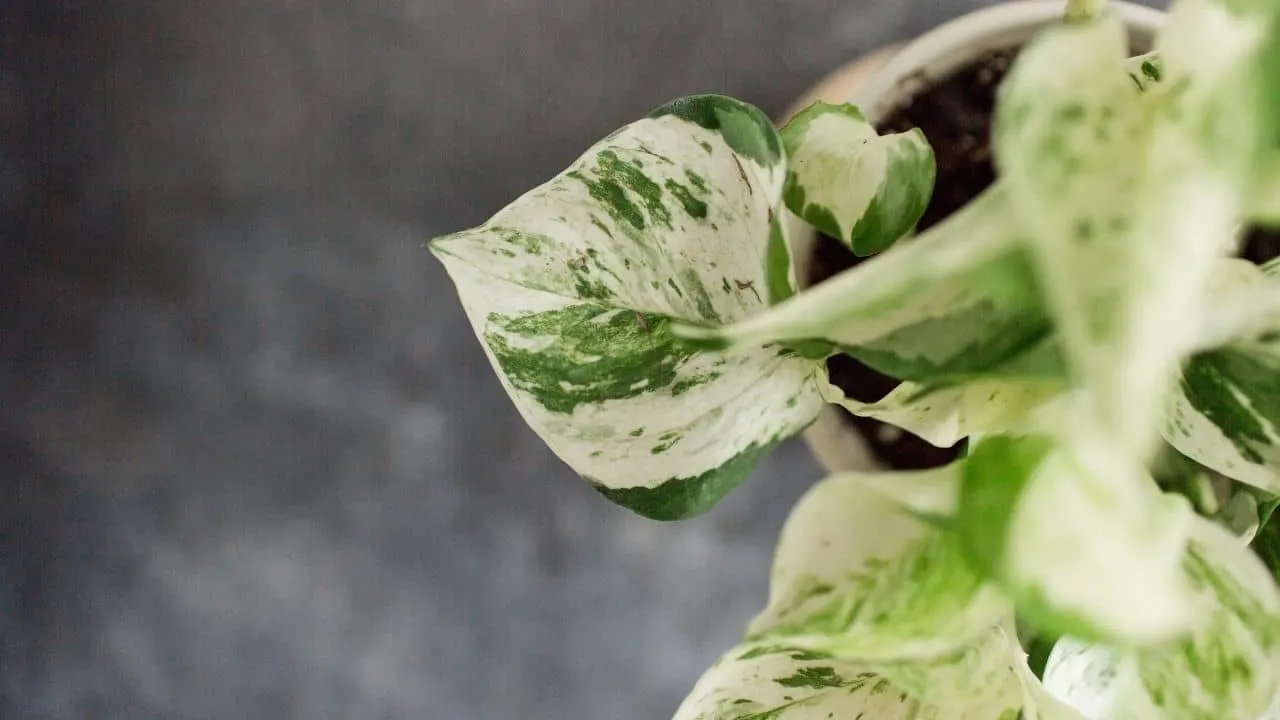
The Pearl and Jade Pothos is a variegated variety with greyish-green leaves. The heart-shaped leaves are also covered with white or cream-colored variegation.
If you support climbing, the Pearl and Jade Pothos variety will reach a maximum size of 10 ft (3 m) as an indoor plant.
This plant is a mutation of the Marble Queen Pothos, with smaller leaves. The leaves will reach a maximum length of 3 inches (8 cm) and a width of 1.9 inches (5 cm).
This plant lasts longer, but it is a slow grower compared to other Pothos family varieties. You can also grow it on a shaded outdoor patio in the USDA hardiness zones 9 to 12. To achieve a bushy look on this plant, prune the leaves regularly.
- Light: Low light levels, partial shade, or artificial lights
- Temperature: 60 to 85 degrees Fahrenheit (15 to 29 degrees Celsius)
- Humidity: At least 70%
- Water: When 1 or 2 inches of topsoil is dry
- Soil: Cactus soil with good drainage
- Common Issues: Spider mites, fungus gnats, root rot
- Scientific Name: Epipremnum Aureum ‘Pearls and Jade’
Silver Pothos
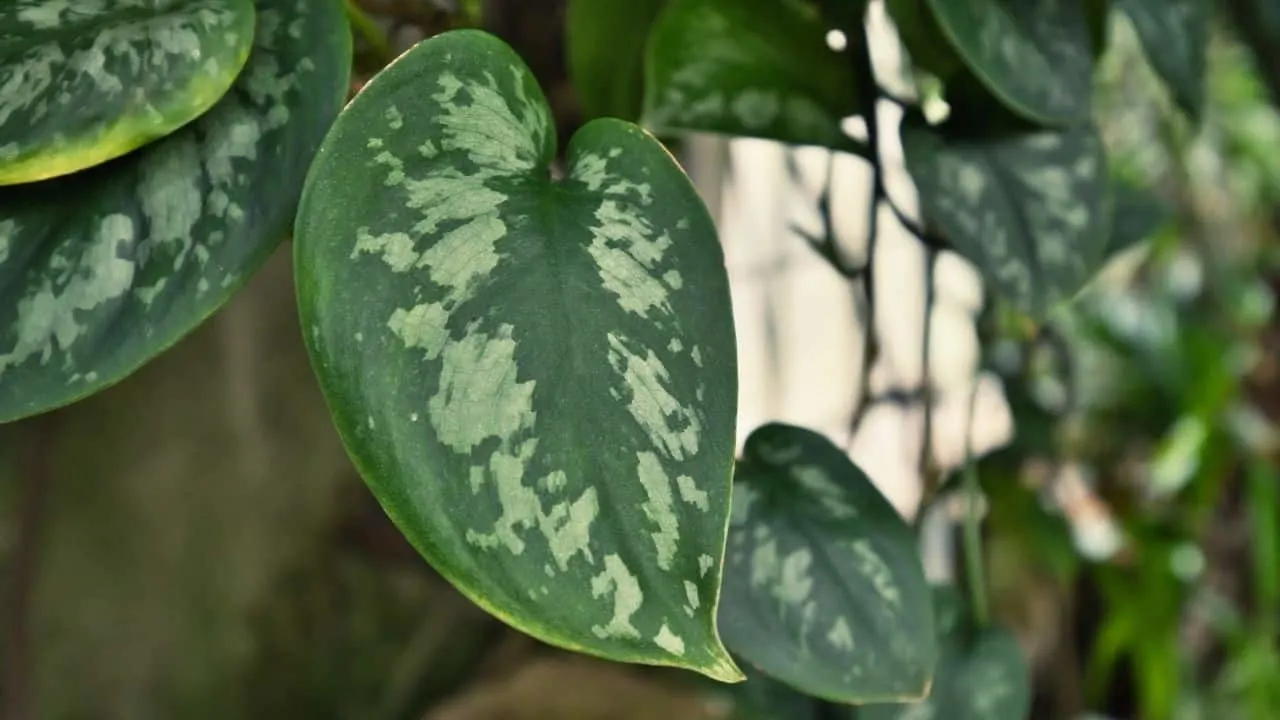
This beautiful variety has a striking color combination because the dark green matte leaves complement the silver markings, hence Silvervine.
The vines can grow anywhere between 3 to 10 ft (0.9 to 3 m). Gardeners also call this plant the Satin Pothos, often confused with Philodendron Silver.
This plant is further divided into subspecies, and the three most popular varieties are Scindapsus Pictus ‘Exotica,’ Scindapsus Pictus ‘Argyraeus,’ and Scindapsus Pictus ‘Silver Ann.’
All these varieties are differentiated based on the silver variegation.
Avoid growing the Silvervine in low light; otherwise, the marking will not be vibrant, and the plant will start losing the variegated pattern.
The silver vine is an Asian native and belongs to tropical rainforests. Successful indoor gardening requires replicating the tropical environment.
This Silver Pothos can be kept on patio, deck, or windowsills, but make sure you plant it in a light soil mixture that drains and retains the moisture efficiently.
- Light: East or west-facing windows where it gets bright, indirect sunlight
- Temperature: 65 to 85 degrees Fahrenheit (18 to 29 degrees Celsius)
- Humidity: Minimum 40 %
- Water: The soil should be watered only when about 2 inches of the top layer are dry
- Soil: Peat-based, well-draining soil teeming with organic matter
- Common Issues: Spider mites, scale, and root rot
- Scientific Name: Scindapsus Pictus
Neon Pothos
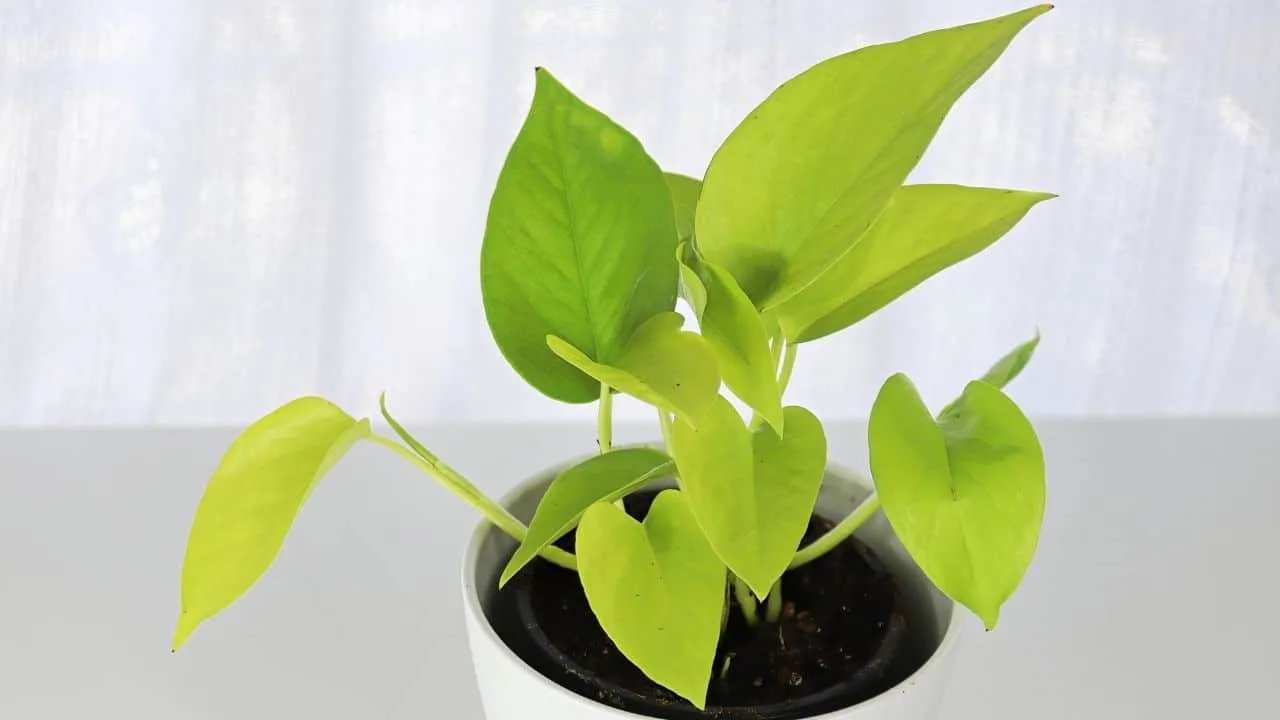
This plant is famous for two main reasons; its hardy nature and bright-colored foliage. It’s best to grow the Neon Pothos as an indoor plant in mild climates and an outdoor plant in tropical regions.
This plant’s yellowish-green electrifying large leaves have a neon glow, especially when young. Therefore, it can brighten up a living room or office space.
The mature leaves measure about 4-8 inches (10-20 cm) in length. As a potted indoor plant, Neon Pothos reaches an average height of 2 to 6 ft (0.6 to 1.8 m).
You have to protect the neon glow of this plant from the direct sun.
Otherwise, the plant will have pale leaves. If you want your plant to reach several feet of height, you have to get the temperature and humidity right. This variety is native to Asia and Australia.
Plant parents are often passionate about feeding their houseplants with some extra fertilizer to help them grow fast, but this will create a disaster for Neon Pothos and can even kill this plant.
If you have little time to care for your plants, you must add this plant to your indoor jungle.
- Light: Low or dim light, fluorescent lights
- Temperature: 65-80 degrees Fahrenheit (18-26 degrees Celsius)
- Humidity: At least 50%
- Water: Once weekly, depending on the temperature and light
- Soil: Rich soil with perlite, potting soil, and coco coir, pH between 6.1 and 6.5
- Common Issues: Mealybugs, brown scales, root rot
- Scientific Name: Chartreuse Epipremnum
Marble Queen Pothos
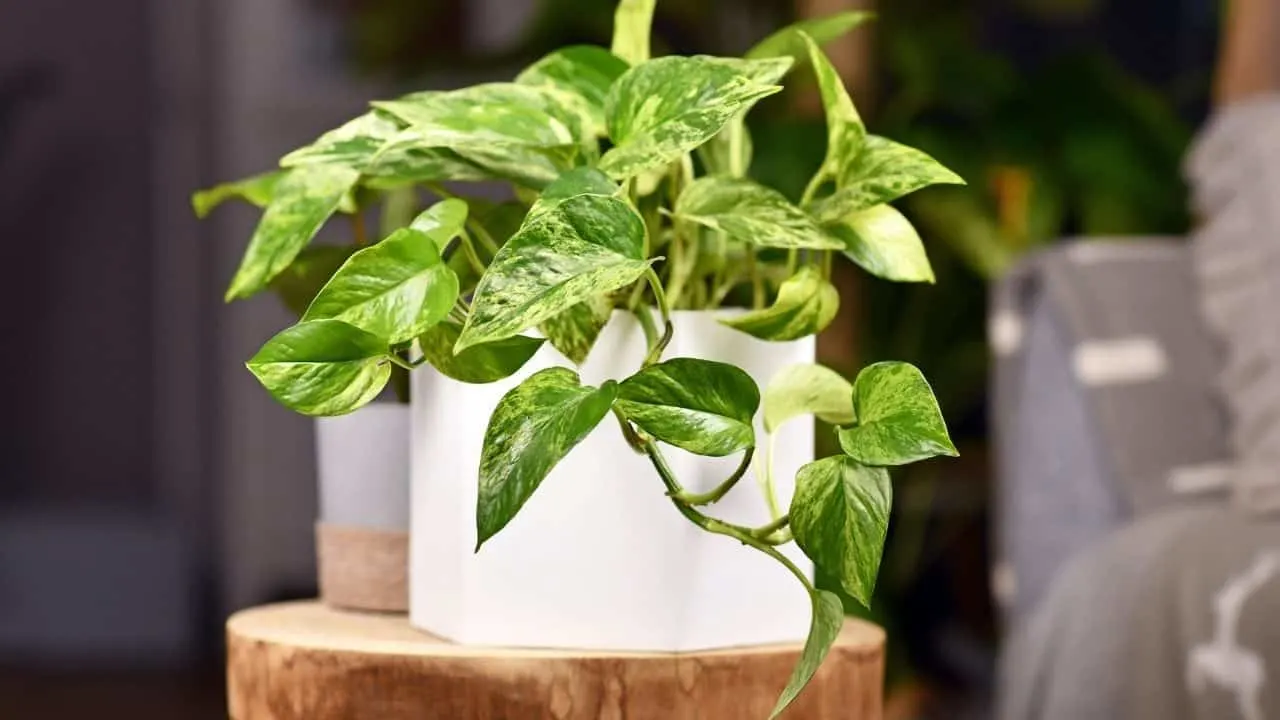
This is one of my favorite varieties; others love it, too, because so many subspecies have been derived from this plant.
The Marble Queen Pothos has cream-colored speckles of variegation. The leaves also vary in shades of light and dark green. This variety is native to French Polynesia.
Even though there is so much hype about this particular Pothos plant, it’s easy for houseplant gardening. This variety is a jewel in any Pothos collection and is rare in local nursery shops.
You must search for it online or source it through a private grower or a plant friend.
This special plant has special requirements in terms of lighting. Otherwise, it’s low maintenance.
Provide it with lots of bright light because it will lose the gorgeous variegation under low light.
The leaves of this plant will help you in caring for it. For example, your plant needs more water if the leaves always look droopy and sad.
If the leaf edges are burned, the light is too intense. So, I would highly recommend paying attention to the appearance of your plant.
Remember that this is a fast-growing variety, so perform pruning to keep it under control. You can also propagate the extra vines and plant them outdoors in a new pot or any location.
Propagation is usually carried out using stem cuttings or root division.
If you maintain the following conditions, your plant will grow up to 5 ft (1.5 m) within the first year. The leaves can also grow about 4 inches (10 cm) in length.
- Light: Bright, indirect sunlight
- Temperature: 65 to 85 degrees Fahrenheit (18 to 29 degrees Celsius)
- Humidity: Average household humidity between 40 and 60%
- Water: Every 7-10 days, when the soil has dried out
- Soil: Good quality potting mix amended with perlite to increase drainage
- Common Issues: Fungus gnats, thrips, mealy bugs, loss of variegation, and leggy growth
- Scientific Name: Epipremnum Aureum ‘Marble Queen’
Click here to read our detailed plant care guide about Marble Queen Pothos care.
Snow Queen Pothos
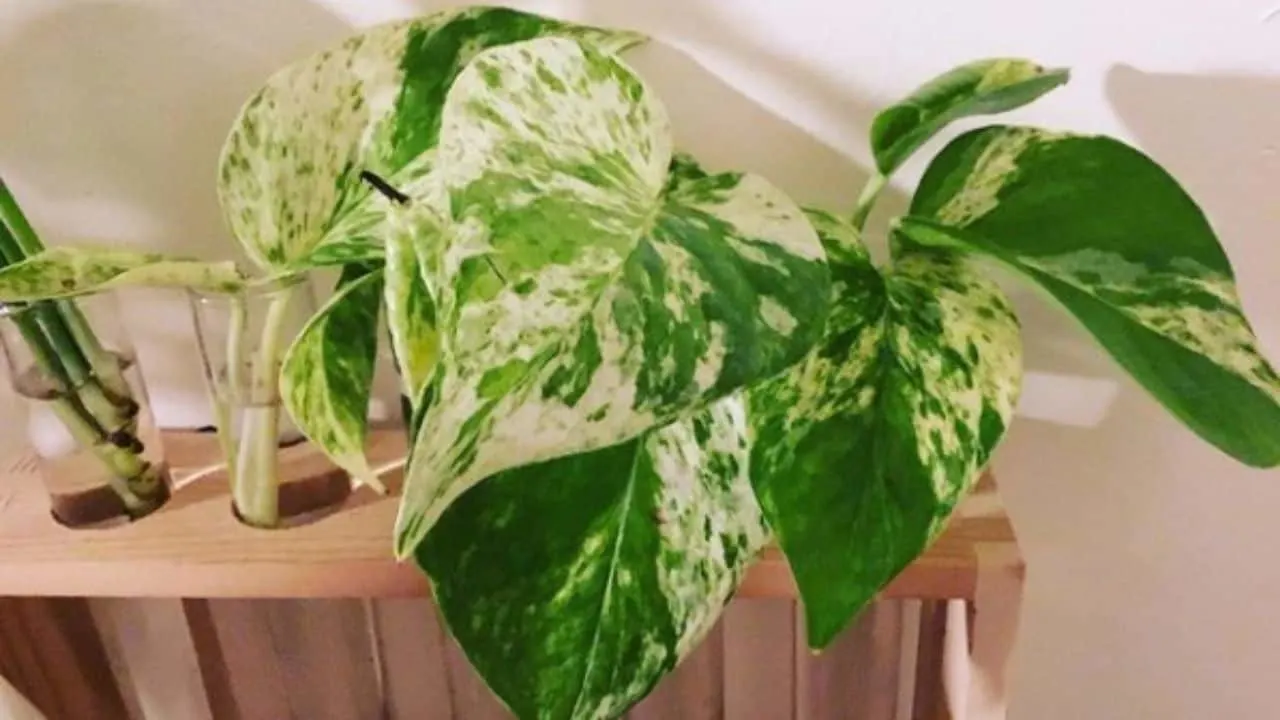
The Snow Queen Pothos has heavy white variegation along with deep green leaves. 80% of the leaf is white the remaining 20% is green.
The wide, heart-shaped foliage will not just adorn your living room but also act as an air purifier.
This Pothos variety is hardy in USDA hardiness zone 10 to 11. This is a medium to fast-growing variety, so you will have an established plant in a short time that is about 6.5ft (2 m) in height
Mist the large leaves every few days to increase the humidity and eliminate the dust. Keep your plant under bright light if you want the white on the leaves to stand out.
This plant is sensitive to direct sunlight as it causes the foliage to turn brown or yellow.
However, dark areas of your house are not the best pick for this plant because a lack of light will force it to revert and look more like the green version of the Marble Queen.
It also dislikes fluctuations in temperature, so avoid placing the pot or hanging basket next to a heating or cooling system. You can grow the Snow Queen as a hanging or climbing plant.
I recommend propagating your original plant via the stem cuttings to enjoy growing it in both ways.
- Light: Bright partial sunlight
- Temperature: 65 to 85 degrees Fahrenheit (18 to 30 degrees Celsius)
- Humidity: 50 to 70%
- Water: Once weekly
- Soil: Rich soil with excellent drainage and pH between 6.0 and 6.5
- Common Issues: Thrips, spider mites, mealy bugs, leaf spot, bacterial wilt
- Scientific Name: Epipremnum Aureum ‘Snow Queen’
N Joy Pothos
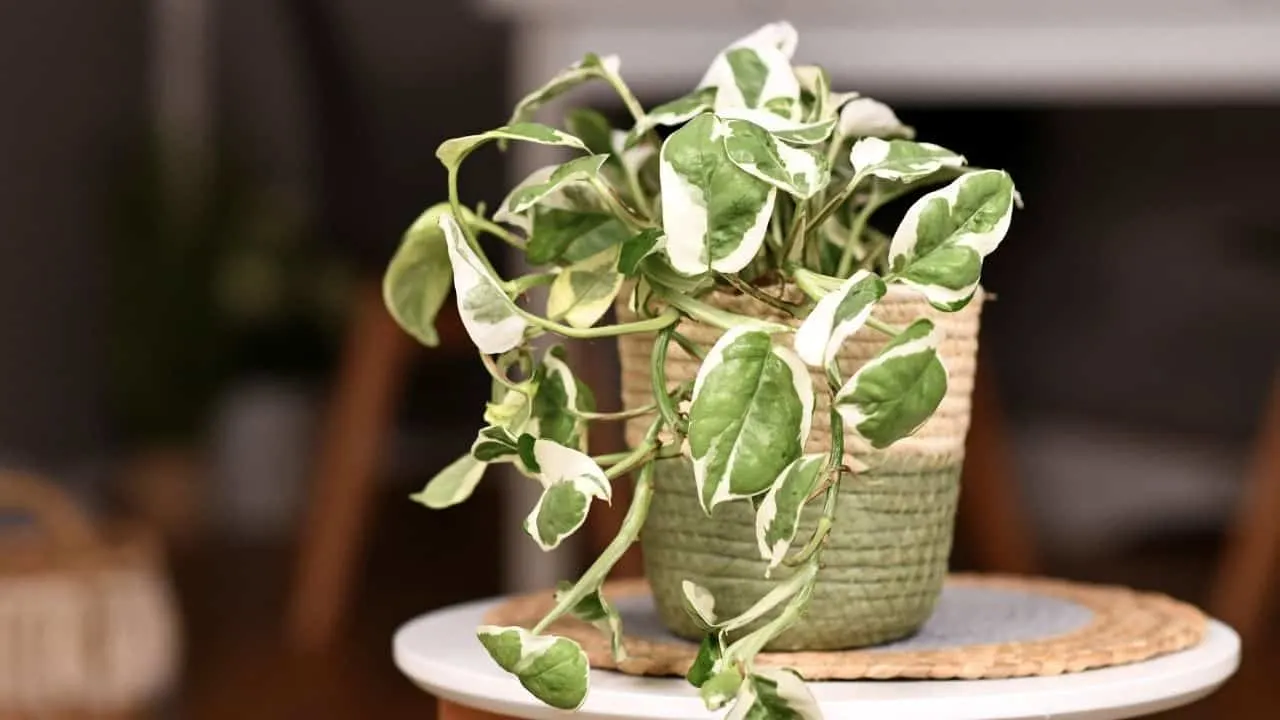
N-Joy Pothos came from the well-known Marble Queen Pothos in 2002. It was created by Dr. Ashish Hansoti, who mutated Manjula Pothos in India.
The leaf size and the variegation pattern on both plants vary a lot, and you can hardly relate them.
This plant can grow up to 9 inches (22 cm) in height, but the vines can grow 10 ft (3 m) in length.
The leaves are irregular and smaller, but the intense cream variegation on the green leaves makes this a must-have Pothos.
The variegation pattern and area covered will vary depending on the light provided to the N Joy plant.
Plants grown under low light have faded variegation, whereas those growing under bright natural or artificial lights have stronger variegation.
Most Pothos do not require lots of fertilizer for healthy growth. The Marble Queen Pothos will appreciate light liquid fertilizer in the growing season.
I love the small bushy appearance of this plant, and it’s thriving in my terrarium.
- Light: Bright, filtered sunlight
- Temperature: 50 to 95 degrees Fahrenheit (10 to 35 degrees Celsius)
- Humidity: 60 to 90%
- Water: Minimal watering needs; add water when 1 inch of soil is dry
- Soil: Any growing medium that contains perlite and peat moss
- Common Issues: Mealybugs, aphids, root rot
- Scientific Name: Epipremnum Aureum ‘N-Joy’
Jessenia Pothos
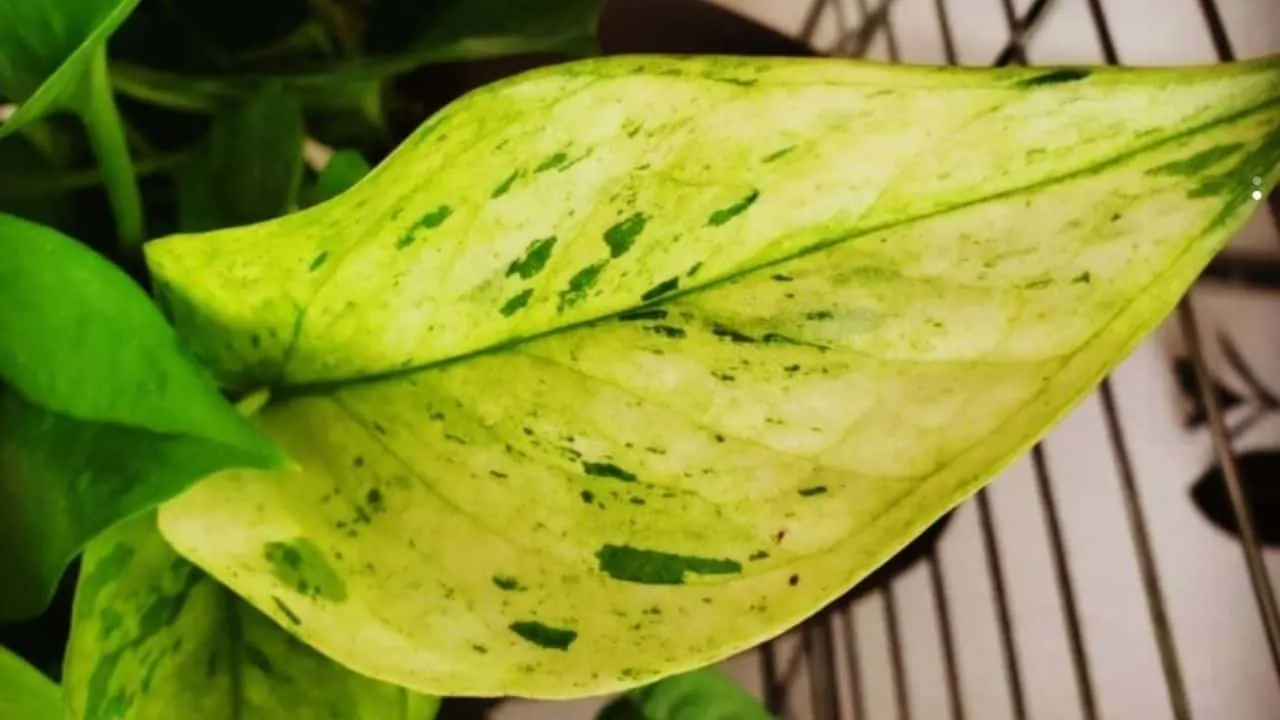
The green leaves on the Jessenia Pothos plant are marked with lime green and cream variegation. It resembles the Marble Queen’s appearance and belongs to Southeast Asia.
What differentiates these two is the lime green variegation on Jessenia Pothos.
The leaves are heart-shaped, but each one is unique. This simple plant will not bother other plants in your garden as it’s a slow grower.
You can attach it to a moss pole, trellis, or hanging basket; it will thrive anywhere.
The trailing vines on this plant can adjust in various growing conditions and get as high as 10 ft (3 m).
This tropical plant cannot handle intense sunlight, but maintaining the right level is important to retain the variegation on the leaves.
Another thing that helps this variety grow vigorously is the moisture in the air, it survives with low humidity, but high humidity creates more favorable growing conditions.
Pothos do not bloom indoors, including Jessenia Pothos, but they will surely purify the air for you.
- Light: Moderate to bright filtered light
- Temperature: 65-75 degrees Fahrenheit ( 18-23.8 degrees Celsius)
- Humidity: 60 to 80%
- Water: When the soil’s top 2 inches are dry
- Soil: Well-draining, nutrient-rich soil
- Common Issues: Whiteflies, thrips, yellow leaves, and root rot
- Scientific Name: Epipremnum Aureum ‘Jessenia’
Jade Pothos
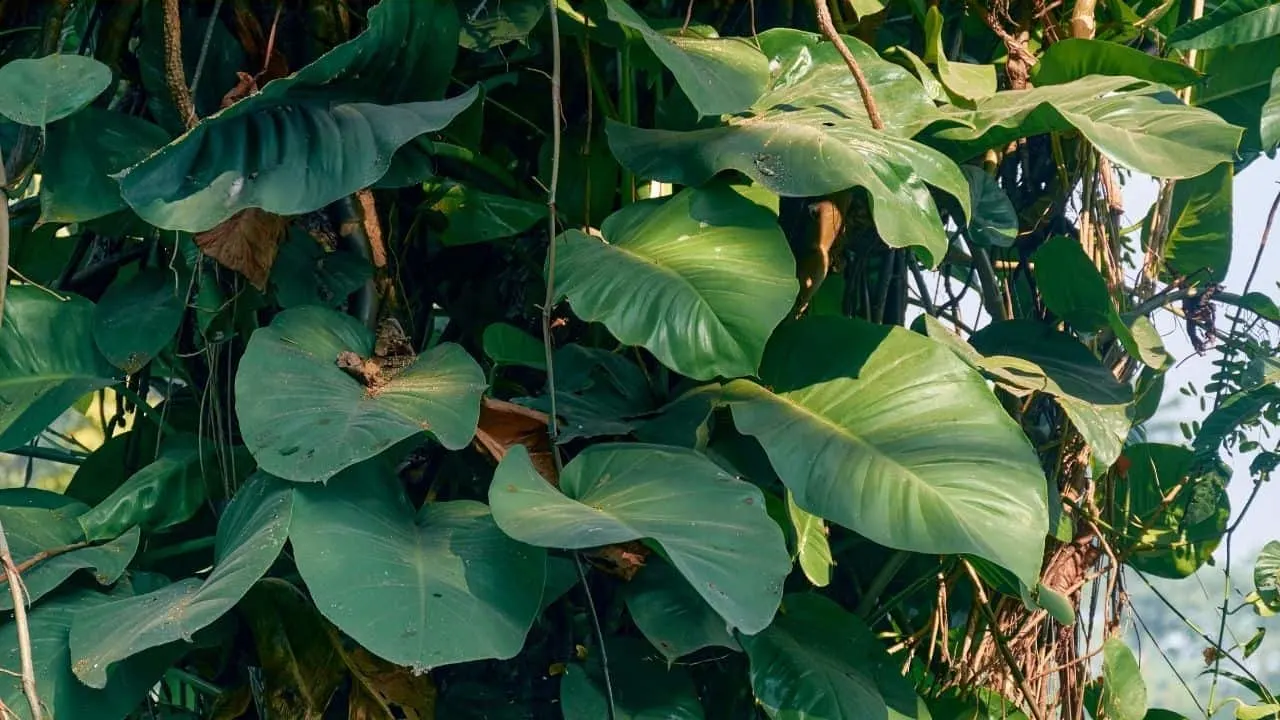
You should get the Jade Pothos if you are looking for a simple plant with classic green leaves. The leaves on this variety are not variegated but add a tropical vibe.
Each leaf of this hardy houseplant is lush and dark green, making it a perfect plant for low-light areas.
The leaves have a shiny texture creating a pleasant display plant for any location. Your Jade plant’s getting too much sunlight if its leaves go pale green.
This variety’s solid green leaves are smaller than the Golden Pothos. It isn’t demanding care, unlike other plants.
I would recommend new gardeners begin their Pothos collection with this plant.
Let this vine grow as large as you like, but I recommend regular pruning to keep the size under 6 – 10 ft (1.8 to 3 m).
You should place the pot on an elevated shelf or showcase it in a hanging basket to let the solid green leaves fall downwards.
- Light: North or south-facing windows where it gets bright, filtered sunlight
- Temperature: 65 to 85 degrees Fahrenheit (18 to 29 degrees Celsius)
- Humidity: Minimum 70%
- Water: When potting soil’s top 2 inches are dry
- Soil: Well-draining soil
- Common Issues: Mealybugs and root rot
- Scientific Name: Epipremnum Aureum ‘Jade’
Glacier Pothos
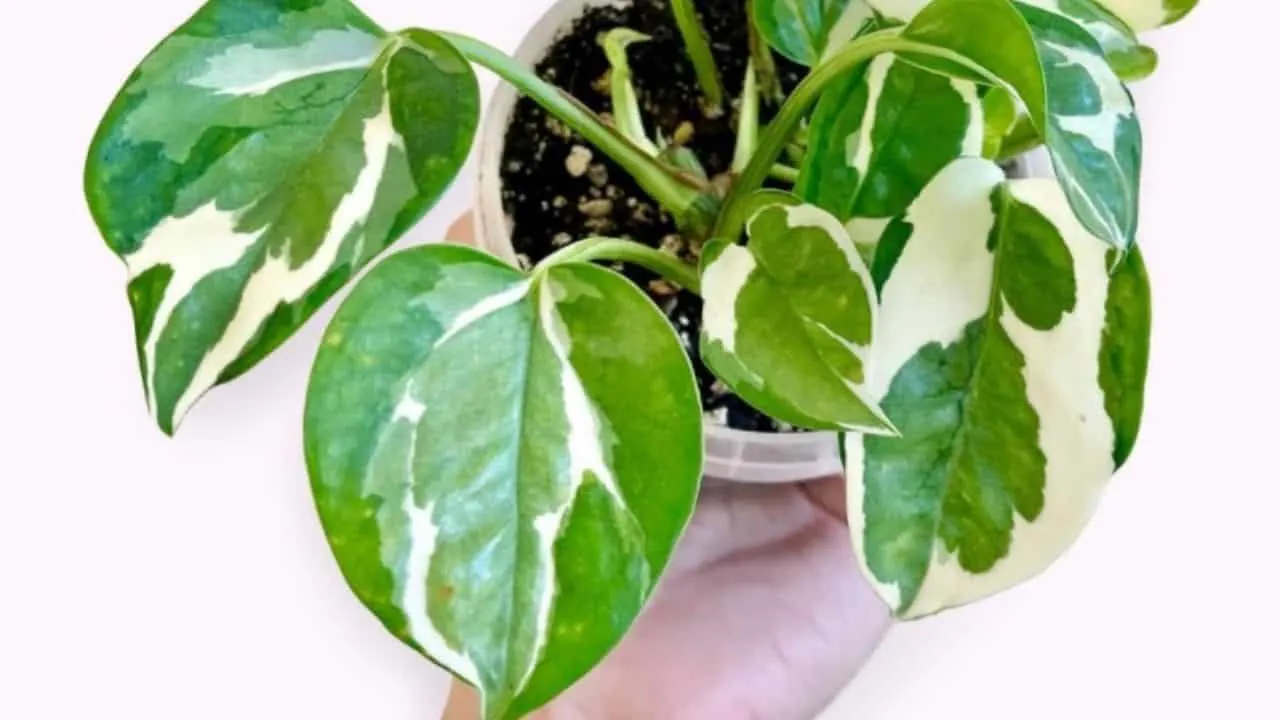
This miniature Pothos is another favorite for variegated plant lovers. The small leaves of this plant are covered with cream and white variegation patterns.
This beginner-friendly plant can adapt to different conditions and forgive you for neglect. The white variegation on the leaves means your plant needs strong but filtered light for most of the day.
Hanging baskets is a popular method to grow Pothos but make sure the top leaves on your Glacier Pothos receive the required light; otherwise, this portion will lose all its beauty.
The best location for this plant is your tabletop or office desk.
- Light: Bright or medium sunlight
- Temperature: 65 to 75 degrees Fahrenheit (18 to 24 degrees Celsius)
- Humidity: 50 to 70%
- Water: Water when the top 2 inches of the growing medium are dry to keep the soil moist, once a week in summer
- Soil: Free draining fertile soil mix, soil pH between 5 and 7.5
- Common Issues: Root rot
- Scientific Name: Epipremnum Aureum ‘Glacier’
Marble Queen Pothos vs. Snow Queen
The Marble Queen Pothos has cream-colored speckles of variegation. The Snow Queen Pothos has much more variegated leaves that sport more white. Both Pothos varieties belong to the Epipremnum genus.
Why Should You Grow Pothos
Did you know that Pothos is commonly known as the Money plant because of the popular belief that they symbolize good fortune and happiness?
Pothos are labeled hard-to-kill plants, and here are some reasons:
- They thrive in low-light conditions.
- They are the easiest houseplant for new and experienced gardeners as they can tolerate neglect.
- They improve indoor air quality by absorbing harmful toxins from the air.
- They make excellent decorative plants for planters and hanging baskets.
- They can be displayed in shopping malls, offices, homes, or other public places.
- They are low maintenance, so you can let the plant grow independently once established.
- They can be grown permanently in water, meaning you do not need a soil medium.
- A great addition for plant owners with limited space.
It can also serve as an aquarium plant.
Conclusion
Indoor and outdoor gardeners love pothos for many reasons. One main reason is that they are easy to care for starter plants.
I have shared some of my favorite varieties in this article; you can start your collection with any of these.
You can also check out the detailed care guides I wrote about Pearl and Jade Pothos, Marble Queen Pothos, Snow Queen Pothos, Neon Pothos, N Joy Pothos, Cebu Blue Pothos, Golden Pothos, and Silver Pothos.

Daniel has been a plant enthusiast for over 20 years. He owns hundreds of houseplants and prepares for the chili growing seasons yearly with great anticipation. His favorite plants are plant species in the Araceae family, such as Monstera, Philodendron, and Anthurium. He also loves gardening and is growing hot peppers, tomatoes, and many more vegetables.

